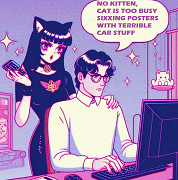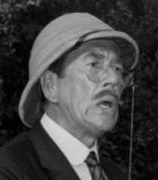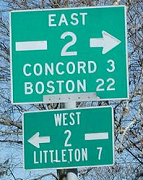|
jadebullet posted:Quick question for Axeman Jim. When you say Pullman, is that the same one as the US based Pullman Standard, or did the UK also, just dependently, have a coach builder with the same name? (I'm thinking it's probably a British Ford situation) The British company licensed the name from the American one and was originally a joint venture in 1882, but became its own thing shortly after with the rights to the name.
|
|
|
|

|
| # ? May 9, 2024 21:25 |
|
Axeman Jim posted:The British company licensed the name from the American one and was originally a joint venture in 1882, but became its own thing shortly after with the rights to the name. Are you going to replace your av with a flaming tube-train DMU when they get put into service?
|
|
|
|
With apologies to Axeman Jim. lovely North American Locomotives: EMD SD50 Ah... EMD. A shadow of its former self. No longer part of GM and no one loves it anymore (I do though  ). ).And this is why:  Nothing says quality like a patch job. Anyway, EMD at the time was the king of the diesel locomotive mountain in North America. The Dash-2 series was a massive success (except the SD45-2, somewhat). Fairbanks-Morse, Alco, Baldwin had all long crumbled, and GE was struggling to get traction against it. For a time anyway. The SD40-2 (and the rest of the Dash-2s, especially the GP38-2) is probably one of the greatest locomotive successes in the diesel era. It was revolutionary and evolutionary and somehow worked. Revolutionary: it completely redid the electrical cabinet, transforming it from a mess of wires that were pains to fix, to modular units that could be swapped in and out as needed. The technology was even proven first by the DDA40X. Evolutionary: it took the same prime mover and alternator as the prior SD40 and adapted it to it, among other small changes. It also introduced the wide-nosed cab every locomotive uses today (technically the GP38-2 did, but close enough). And it sold like hot cakes. Hundreds (at least) of SD40-2s and GP38-2s still roam the rails, a testament to their design and quality.  The King of the Rails in the 70s  However, GE figured out how to make a 3600 HP locomotive and make it reliable. The SD45 and SD45-2 both had issues (SD40 reliability, SD45-2 "gas guzzler"), and GE was doing it with 16 cylinders, not 20. GM had to respond (and was the beginning of the "Horsepower Wars" between the two, culminating in the AC6000CW and SD90MAC, both worthy of their own essay). The EMD 645 was a solid engine in 12 and 16 cylinder configurations (it had the same block as the proven 567 but with a bigger bore, among other changes). At the time, the oil crisis was going, so 20 cylinders were pretty much a no go. They needed 3500+ HP but in 16 cylinder form. So they upped the RPM from 900 to 950 at notch 8, giving out 500 more HP than the SD40s (later bumped up to 3600 HP). A nice, evolutionary step, right? Some other changes were made, like moving the dynamic brakes from above the engine to right behind the cab, closer to the switchgear (which was the Dash-2 modular units still) and in a cooler location. Louder for the crew, sure, but they only needed one fan to cool it now instead of two (GP50s still had theirs above the engine). They also became standard at this point. Some lengthing of the frame as well, and suddenly EMD has a brand new loco putting out 3500 HP and a return shot at GE's Dash-7. No real drastic changes (arguably), just general improvements all around. GM figured name, reputation, and better finacial offers would carry the day.  Not to be confused with the SD60 One problem: the engine was poo poo. The 645 was great in a 900 RPM configuration, but was absolute poo poo in 950 RPM form. Reliablity issues with both the engine and the electrical gear tanked orders, and more companies went to GE for new locos. EMD hasn't recovered since. The SD60 was also much better with the 710 engine (an evolution of the 645: same block, same bore, but longer stroke) and microcontrollers instead of traditional switchgear, but by that point it was too late. GE now rules the rails in the US, even if they like to eat their own turbos (mmm toasters). Would EMD be doing better had the SD50 not been utter poo poo? Maybe. I don't think the SD90MAC would have tanked EMD, mostly because that was largely a limited interest loco, and its GE counterpart was only slightly better and only just that (only three companies ordered them and only one still runs them in 6000 HP configuration). Oh, and most of the surviving SD50s have been derated down to 900 RPM/3000 HP, essentially making them SD40-2s in an SD50 package, and occasionally getting microcontroller upgrades. They're also much more reliable, go figure.
|
|
|
|
This is that post of contact the size of a dime that people often talk about.
|
|
|
|
Axeman Jim posted:air travel and haulage industries eagerly embraced the possibilities of change (except the British government, of course, who formed a gigantic committee and produced the stupidest aircraft ever built), At least the Brabazon had the basic idea that massive, pressurised multi-engined land planes were the future (just not ones with piston engines and designed to carry about 100 passengers in something the size of a B767 - BOAC wanted the Brabazon to carry just 25 passengers...but it would have an on-board cinema!) The stupidest aircraft was the Saunders-Roe Princess, which was the same idea but with 10 engines and it was a flying boat. Because if there's one thing the world was short of after WW2 it was lots of underutilised airfields with long concrete runways... CAT INTERCEPTOR posted:How the gently caress did they ever come up with something as good as the HST????? Because the HST was a semi-official backroom project that was never supposed to happen. It was a cheap and cheerful Plan B for the surely inconceivable case in which the APT failed to work. So no one was interested it, all the engineers with daft ideas ignored it, as did all the BR managers and the politicians. So those on the HST project were left to take the Blue Pullman - a decent idea badly executed - and sort it out. When the APT shockingly turned out to be a complete turkey the HST was ready to take over and it basically worked straight out of the box. The post-war British rail, car and aircraft industries were all hamstrung by this same refusal just to have normal ideas and do them well. They were always trying to innovate in massive leaps and bounds, creating niche products that were fantastic technical acheivements but which had no commercial demand or usefullness. Every now and then one slipped out despite the best efforts of the system!
|
|
|
|
This question gets asked again and again, so let’s address it: Non-Crap British Trains (a very short series) – The British Rail Class 253/254 “High Speed Train”  Why was the HST not a Crap British Train? Aside from the mighty “Deltics”, the HST is probably the only train produced by Britain since World War 2 that could really be described as the best in its class anywhere in the world, both at the time and in the decades since. But as we have seen, it is not in much company – British Rail (and its privatised successors) disgraced themselves time and again with their embarrassments-on-wheels, so how did the HST end up being probably the greatest diesel passenger train ever constructed? 1 – It learned lessons from the Modernisation Plan BR’s 1955 Modernisation Plan was a colossal disaster, at least as far as the procurement of new trains went. British Rail, under the guise of the British Traction Council, ordered the wrong types of locomotives from builders who by and large had no idea what they were doing, in a massive panic due to a politically-motivated diktat mandating the replacement of all steam on the network by 1967, with BR having basically no diesels at all in 1955. This led to operational chaos and a financial meltdown, which in turn led to the equally botched Beeching cuts of the 1960’s, which were supposed to cut costs but ended up cutting revenue instead. These disasters haunted British Rail throughout its life and still affect the network today. The HST, though, was a fresh approach, not so much in terms of engineering (although there were some innovations, notably its passenger coaches), but in terms of procurement philosophy, marking the first time that BR’s train-building was driven by passenger and market need rather than either centralised bureaucratic planning or a child-like desire to play with a fancy new toy.  “But moooom, every other railway has a gas turbine engine, I want one too!” “Fine, we’ll get you one from the dollar store.” With 20 years having passed since the Modernisation Plan, BR were able to assess its many failures and actually learn from them. For instance, the Modernisation Plan’s obsession with dual-purpose (passenger and freight) locomotives produced hordes of crap locos that weren’t any good at hauling either type of train. By the 1970’s BR had figured out that specialised traction was the way to go, and this enabled BR to design a self-propelled trainset with dedicated power cars, optimised for high-speed passenger work and nothing else. No need for a second cab, no need for compromised multi-purpose gear ratios, vacuum brakes, slow-speed control or any other systems that would add weight and complexity. The HST was lean and efficient at what it did, which was to move passengers long distances at high speed, and nothing else. Compare that with the Class 50 that the HST replaced on the Great Western main line, a lean, effective English Electric express passenger loco design that BR wrecked by insisting it be able to haul heavy coal trains for some mad reason and shoved all sorts of gadgets into that filled up the engine compartments with bulky, heavy crap, compromised the engine ventilation, and caused its prime mover to overheat, boil its lubricant, and seize/catch fire/disintegrate/all three.  Nothing to see here, move along The HST was also prototyped properly, as opposed to many of the Modernisation Plan classes that were rushed straight into squadron service without any testing to meet the arbitrary political deadline for the end of steam, with predictable results. The Blue Pullman (see previous post) was not a failure in terms of its concept, it was a failure because it was applied to the wrong market, naively designed and badly engineered by an incompetent subcontractor. The promise of the trainset configuration for fast passenger work was not a new one, even when the Blue Pullman was built, as the 1930s had seen the introduction of the legendary German “Flying Hamburger” sets and the American “Zephyr” streamliners, and if the technical problems of the Blue Pullman could be overcome the result could be exceptional.  It vas fast und vent to Hamburg, zere iz nothing funny about ze name, dumkopf Amerikaner! 2 – It benefited from its tight budget Similarly, the idea of using a lightweight, force-charged V-12 diesel engine was a good one, the only problem was that the unit installed in the Blue Pullman was complete garbage. The HST just needed a better engine. Whereas the BR of 1955, flush with Marshall Plan cash and the optimism of the Atomic Age, would have installed some kind of untested solid platinum revolving W16 nuclear turbine fuelled by distilled unicorn jizz, in the cash-strapped, bailed-out-by-the-IMF 1970s, BR could only afford to modify an existing, very conventional diesel engine. The 4-stroke intercooled Paxman Valenta engine was the descendent of the notoriously terrible Ventura, installed in such lemons as the Class 29 and Class 74, but since those days Paxman had been acquired by English Electric, the only British company capable of building a decent large diesel engine, and immeasurably improved, and attached to a proven alternator from the successful Class 47. To get the power to weight ratio and compact size required, EE designed a gigantic turbocharger that brought the engine up to 2250HP. Do you know what the turbo whine of the sort of turbo required to boost a 79 litre V12 sounds like? It sounds like this: https://www.youtube.com/watch?v=UUK94mIcyKw The lack of cash also contributed to the lack of unnecessary equipment that cut weight and complexity. As with the Blue Pullmans, this enabled the power cars to contain luggage compartments, increasing space for passengers in the new Mark 3 carriage design. Such was the weight saving that in 1977 the Class 43 (HST power car) was able to fit not only a 2250HP power plant with room for a baggage compartment to spare, but reach the axle load limitations of high speed passenger work with just a 4-axle design. Compare this with one of the more “successful” Modernisation Plan diesels, English Electric’s Class 40 of 1958 (only 19 years before), that was so heavy it needed EIGHT axles to haul its corpulent bulk around, and only generated 2000HP.  “I’m just big-chassis’ed” 3 - The APT project acted as a meat-shield This was perhaps the biggest secret of the HST’s success, and ironically came from a disaster of gigantic proportions even by BR’s standards. The HST, cheap - low-profile, market-driven and efficiently engineered - was the yin to the APT’s horrifically expensive, highly politicised, technology-driven and overbuilt yang. The Advanced Passenger Train project was probably British Rail’s biggest procurement disaster since the Modernisation Plan, and certainly the most high profile. The APT was basically the Star Citizen of trains – impossibly ambitious, riddled with feature creep, promising all manner of things it couldn’t possibly deliver and a black hole into which almost all of British Rail’s precious cash was sucked. Whilst British Rail’s Research division was busy promising everyone that the APT would emit healing energy out of its exhaust vents and be capable of time travel, BR’s Inter-City division (the only division that was making a profit), pointed out that they needed new trains and needed them now, because the Modernisation Plan locomotives they had were busy vibrating themselves to pieces or catching fire. Besides, the APT would be electric, and the non-electrified mainlines would need to be converted before the APT could replace the rustbuckets currently coughing along them, and BR was too busy spending every spare penny it had trying to give the APT a warp drive or shark-repelling laser cannons to bother with such trivia as “building track that it could actually run on”, despite the only electrified main line the APT could actually use having recently acquired new electric locos that were actually pretty good.  Track? Signals? Booooring!! You can’t even paint fancy stripes on those or make them look like a Lamborghini! So BR’s board reluctantly agreed that new diesels would be built to be “stop-gaps” until the three main lines without electrification (The East Coast, Midland and Great Western main lines) could be converted, at which point the HST would move to secondary lines. 40 years on, and only the East Coast main line has been (cheaply, badly) electrified, and even then not all of it, and HSTs still run on those sections and the other two lines. BR Engineering’s promise to develop new lightweight coaches as part of the project to replace unsafe and overweight Mark 1 stock also helped sweeten the deal, and the design that resulted – the phenomenally successful Mark 3 – offered a 50% weight saving per seat compared to the previous Mark 2, superlative crash resistance that still meets modern standards today, improved aerodynamics and air-conditioning as standard, as well as forming the basis for a whole generation of multiple unit trains. Arguments continue today about whether the APT could ever have been a success – if it hadn’t had the plug pulled at the time it was, or if it had been approached differently from the beginning. It’s impossible to say for sure, but what is certain what that the APT was just as much a political project as it was an engineering one and that’s seldom a recipe for success. BR, very sensitive to government mutterings about splitting it up, selling it off or even bulldozing the entire network to make way for motorways (yes, this was being seriously suggested), wanted to prove to the government, the public, and the small army of hack stand-up comedians who were paying their bills by making cheap gags at its expense, that it could produce something truly world-class. Which of course it did, but that train was not the APT, it was the cheap, unglamorous stop-gap HST that was only supposed to run for a few years whilst the main lines were electrified to make way for the APT. To that end, the APT was festooned with the latest, untested gadgets, all of which had to be tested together. New tilting system, new power system, new brakes, new controls, with no existing platform with which to test each system. As any systems engineer will tell you, this is a nightmare scenario as it makes troubleshooting nearly impossible, as there is no baseline to compare failures or unexpected behaviour against in order to troubleshoot complex, emergent problems. The HST, by contrast, involved very little genuinely new technology just a very lean, effective and specialised application of existing ideas. This was similar to the slightly earlier Shinkansen “Bullet Trains” of Japan, which on a technological level were not a huge advance – they were just highly focused, efficient applications of existing technology to a very specific purpose, driven by what customers wanted rather than the exciting possibilities of a new gadget. Re-engined HSTs are still the primary motive power on the UK’s non-electrified main lines, 40 years on from their introduction, and likely to pass the half-century mark as tentative plans to replace them are only just reaching the prototype stage, and not for every route they currently serve. Axeman Jim fucked around with this message at 21:27 on Jan 5, 2017 |
|
|
|
Axeman Jim posted:Non-Crap British Trains (a very short series) – The British Rail Class 253/254 “High Speed Train” THANK YOU! Right; if you're not making your Crap British Trains series into an actual small book à la "Roundabouts of Britain" you're a fool. Axeman Jim posted:Do you know what the turbo whine of the sort of turbo required to boost a 79 litre V12 sounds like? It sounds like this: I miss the Valentas 😁 Axeman Jim posted:
Did you hear Sir Kenneth Grange on R4? http://www.bbc.co.uk/programmes/b086l4zd
|
|
|
|
Axeman Jim posted:This question gets asked again and again, so let’s address it: Great stuff as always! What would you reckon the full list of Non-Crap British Trains to be? Sticking with just locos it has to be just: - Class 08 (English Electric) - Class 20 (English Electric) - Class 37 (English Electric) - Class 47 (Brush) - Class 55/Deltic (English Electric) - HST (BREL) - Class 58 (BREL) Kinda proves that if BR had just ordered one loco type in each Type class, and ordered them from EE that they could have saved a whole lot of bother and money. Tellingly EE never made a Type 1 loco (probably because they realised they were pointless) and all the ones that did get built were crap, with the possible exception of the Class 14, which was a non-crap but very-pointless loco.
|
|
|
|
Even the Non Crap British trains shows up just how bad BR truly is. Bravo Axeman, well written and informative as always
|
|
|
|
Man it's odd looking at the list of bad locomotives, I mean for comparison Amtrak had in terms of crap, the old SPFs, the E60 (and even that was a solid commuter and long distance train), and metroliner (and that turned into a solid cab car that still runs), and to a lesser extend the HHP-8.
|
|
|
|
Even the SPF had success as a freight unit
|
|
|
|
BalloonFish posted:Great stuff as always! Class 58 was awful, particularly commercially (BR took a massive bath trying to market it for export) but also had serious technical problems, hence it lasted less than 20 years in the UK - I did a post about it in this thread somewhere if you search my posts. I agree with the rest of the list, although only the Deltic was very far above "mediocre". I might also add the Class 33 (BRCW) to it as well, could do just about anything and lasted forever, even if it was (like so many other classes) underpowered. I also agree about the Class 14 - solid design, but designed for work that did not exist, though it eventually found a home in private industry, and the Coal Board examples worked until the mid 80's, and one was hauled out of preservation to help build HS1. The Class 20 was a "type 1" loco in service, and BR ordered three batches of them when it became apparent that nobody else seemed capable of making a functional locomotive in the Type 1 power range. It would have been equally useless if it weren't for the ability of BR to just couple the things back to back in pairs and gain a useful 2000hp freight unit with very high tractive effort for its engine power, ideal for dragging coal which is what they did for decades.
|
|
|
|
Ryand-Smith posted:Man it's odd looking at the list of bad locomotives, I mean for comparison Amtrak had in terms of crap, the old SPFs, the E60 (and even that was a solid commuter and long distance train), and metroliner (and that turned into a solid cab car that still runs), and to a lesser extend the HHP-8. How did we both forget about the B32-8WH? Though they also had probably the best paint job of any Amtrack loco in the original paint.
|
|
|
|
I was going to suggest the class 25 for being seemingly everywhere, but I think they were not super reliable? (And then I found that the last one was apparently withdrawn 30 years, and if that's right then I'm suddenly feeling very old...). Class 26? Comparatively not that many, I suppose.
|
|
|
|
The 25 was underpowered and not very reliable, they just made a lot of them. There was nothing it could do that the Class 31 couldn't do better which is why they didn't last past the end of the 80's whereas the 31, for all its many flaws (overweight, underpowered, original engines so bad they had to be replaced, uglier than fried shite), is still going in small numbers nearly 60 years on because it's basically indestructible. The 26 was basically a lower-power version of the Class 33, and actually had the same engine as the Class 25 (and the Class 24 and 27). It lasted longer than the 25 and 27 because those classes had the same engine uprated from 1160hp to 1250hp to try to squeeze more power out of them by increasing RPM, but as we saw with the SD50 that's not often a very good way to increase engine horsepower and both classes 25 and 27 (which were basically the same design built by different manufacturers) had terrible failure rates due to engine wear.
|
|
|
|
http://i.imgur.com/cub4oMF.gifv
|
|
|
|
I deal with that every day, but I work on ferries.
|
|
|
|
Axeman Jim posted:Class 58 was awful, particularly commercially (BR took a massive bath trying to market it for export) but also had serious technical problems, hence it lasted less than 20 years in the UK Class 33 is a good shout, and I agree that the Deltic and the HST are the only two that truely deserve to be considered genuinely world-class rather than just 'Non-Crap'. I've looked up your 58 post and learnt a lot; I always thought it was a decent enough loco (BR finally trying to make a USA-style conventional, modular hood unit from largely pre-existing parts) but it just became a bit useless due to the decline in heavy industrial traffic and flopped commercially because the whole world just went "British locos, lol!!!!" and ignored it. Heartening to see that it was actually just another Crap Train. I noticed one thing was missing from your Class 60 writeup (which probably means it's not true) but wasn't the alternative proposal for GEC to assemble a UK-specific loco using EMD SD40-2 running gear? The government didn't like that because it wasn't sufficiently BUY BRITISH! and went for Brush's high-tech masterpiece with the engine from a car ferry which didn't work. So everyone ended up buying UK-specific versions of the SD40-2 anyway but they were all built in Canada. Score another own goal for British manufacturing!
|
|
|
|
BalloonFish posted:I noticed one thing was missing from your Class 60 writeup (which probably means it's not true) but wasn't the alternative proposal for GEC to assemble a UK-specific loco using EMD SD40-2 running gear? The government didn't like that because it wasn't sufficiently BUY BRITISH! and went for Brush's high-tech masterpiece with the engine from a car ferry which didn't work. So everyone ended up buying UK-specific versions of the SD40-2 anyway but they were all built in Canada. Score another own goal for British manufacturing! That would be General Motors Diesel (GMD). Alco did the same thing with Montreal Locomotive Works (MLW) to get around tariffs. The SD40-2 is probably one of the most solid locomotives ever made, as evidenced by the fact that they're everywhere, still. Sadly the plant that was in Canada is gone now, 1 part "gently caress you" to workers (strike), 1 part EMD's business is still down (thanks SD50), and 1 part they built a new plant in Indiana.
|
|
|
|
Help? What are the parts marked in red called and what are they for? I'd google, but I lack any terms to search by.
|
|
|
|
Pierzak posted:Help? What are the parts marked in red called and what are they for? I'd google, but I lack any terms to search by. I'm going to guess smoke deflectors? But not of any that I've seen before.
|
|
|
|
 
|
|
|
|
That is one serious cowcatcher
|
|
|
|
http://i.imgur.com/cub4oMF.gifv
|
|
|
|
Pierzak posted:Help? What are the parts marked in red called and what are they for? I'd google, but I lack any terms to search by. Yes, smoke deflectors, designed to guide smoke away from the driver's field of vision. There are various designs, that one is quite unusual, they're usually attached to the sides of the boiler rather than the top.
|
|
|
|
What're you complaining about, the track is good enough to keep the train going forward without derailing it. Stop complaining, there is nothing wrong there.
|
|
|
|
Meanwhile, on the MBTA Green Line northern expansion...
|
|
|
|
Pierzak posted:Help? What are the parts marked in red called and what are they for? I'd google, but I lack any terms to search by. Yup, those are smoke deflectors. They're also known as elephant ears on the US.
|
|
|
|
iospace posted:I'm going to guess smoke deflectors? But not of any that I've seen before. Axeman Jim posted:Yes, smoke deflectors, designed to guide smoke away from the driver's field of vision. There are various designs, that one is quite unusual, they're usually attached to the sides of the boiler rather than the top. Tex Avery posted:Yup, those are smoke deflectors. They're also known as elephant ears on the US.
|
|
|
|
I was decluttering, and found these two promotional Metroliner paper models at the bottom of a pile of stuff. I was gonna throw them out, but I remembered this thread and thought I'd run it by you guys first. They're yours for postage, complete with "Hey it's not the 90s anymore but we wish it was" graphics and all, if anyone's interested. Thanks for this thread. I'd like to know more about train whistles. I swear I would be able to tell who was driving by the pattern of their signals, if I could put names to horns. Sometimes we get a train that comes through, and the guy on the horn, he plays it like an old timey western choo choo, with a lot of soul in the notes, rather than just yanking out the notes mechanically.
|
|
|
|
Sun Dog posted:I was decluttering, and found these two promotional Metroliner paper models at the bottom of a pile of stuff. I was gonna throw them out, but I remembered this thread and thought I'd run it by you guys first. They're yours for postage, complete with "Hey it's not the 90s anymore but we wish it was" graphics and all, if anyone's interested. This isn't the Manchester Metrolink, yeah? poop poop!
|
|
|
|
meltie posted:This isn't the Manchester Metrolink, yeah? US Metrolink! I got these at the Camarillo station, California, US. Disclaimer: I know little more about trains than I like how they look and sound and feel
|
|
|
|
Oxnard is the one with a proper station, Camarillo is just a stop. Chatsworth has a station too. I used to take the train from Chatsworth to Oxnard and would have continued doing so if I hadn't moved. Four months later there was the train collision. I probably dodged a bullet there.
|
|
|
|
|
Hunter Harrison out early at CP, but apparently he may go to CSX? http://www.railwayage.com/index.php/blogs/william-vantuono/creel-to-succeed-harrison-at-cp.html I mean, he did want CP to merge with CSX before the DoD said "lol no", maybe he'll try to get CSX to buy out CP?
|
|
|
|
both unions are urging their members and public to contact their representatives on this http://www.ble-t.org/pr/news/newsflash.asp?id=5924 edit: quote:Dear Representative Liz Cheney: B4Ctom1 fucked around with this message at 21:54 on Jan 23, 2017 |
|
|
|
https://www.youtube.com/watch?v=HD89wPiicCg
|
|
|
|
the end made me lol
|
|
|
|

|
|
|
|
On one hand, THERE IS A HORN FOR A REASON. On the other, when you're driving a big rear end truck like that, slamming on the brakes in snowy weather can lead to not fun, so I think the driver was screwed either way. Also this: Cygni posted:the end made me lol
|
|
|
|

|
| # ? May 9, 2024 21:25 |
|
Cygni posted:the end made me lol I like how he didn't know whether to put the brake on or not after getting hit. I bloody well wouldn't know either.
|
|
|



































